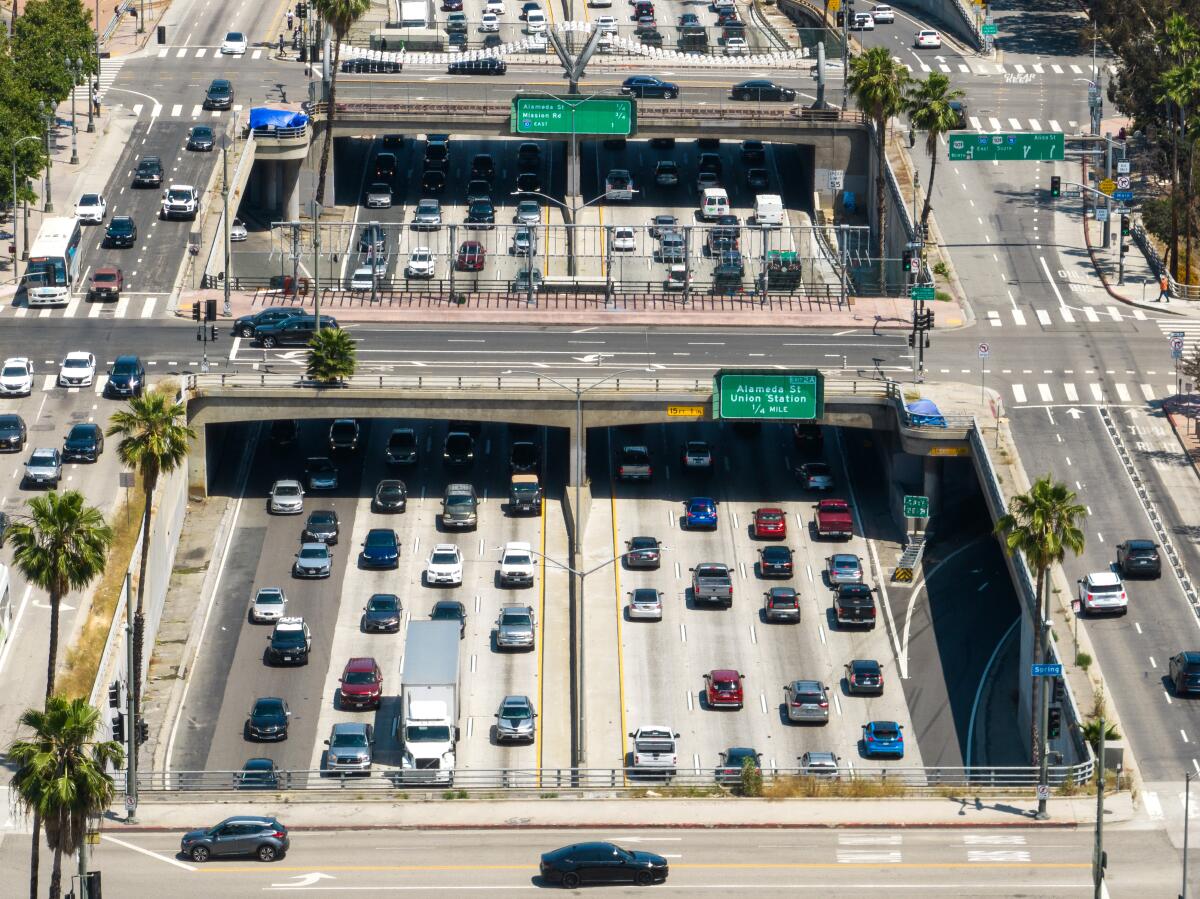A lack of affordable housing sentences Californians to brutal commutes

- Share via
Good morning. It’s Wednesday, Dec. 20. I’m Terry Castleman, a data reporter for The Times. Here’s what you need to know to start your day.
- A lack of affordable housing sentences Californians to brutal commutes
- The wealthiest Californians are fleeing the state
- 18 L.A. restaurants for dinner or takeout on Christmas Eve and Christmas Day
- And here’s today’s e-newspaper
Sign up for Essential California
The most important California stories and recommendations in your inbox every morning.
You may occasionally receive promotional content from the Los Angeles Times.
California’s sprawl means unequal commutes
It’s one of our readers’ favorite topics: the exodus of people from a state that has known nothing but growth in its storied history.
Over the last year, I took a long look at the many factors contributing to a so-called California exodus, and spoke to dozens of former Californians who chose to relocate.
They told a consistent story, describing an inverse of the Gold Rush that brought so many to California. As the state has grown less affordable, opportunity draws some people to other frontiers.
My colleagues and I have written a number of stories about the states on the receiving end of the exodus:
- Maria L. La Ganga wrote about Idaho in 2019
- Noah Bierman and Don Lee wrote about Nevada in February of this year
- Hailey Branson-Potts wrote about Florida a few weeks ago
- I covered the droves of Californians departing for Texas in November
Not everyone who is challenged by California’s cost of living leaves, and those who stay face a housing crisis. Specifically, they are made to endure punishing commutes as the job centers of Southern California become less affordable and population growth occurs in the suburbs and exurbs, as I report in my latest story.
Those job centers, like Orange County and Los Angeles’ Westside, are far from the exurbs of Riverside or San Bernardino counties where housing growth is higher and prices are lower.
This directly relates to a phenomenon I have dubbed the cross-county commute. In writing about the state of commutes in SoCal, I found that about 750,000 people commuted across county lines in 2020.
The number has steadily increased over decades, largely driven by those who live in counties such as San Bernardino and Riverside and commute to Orange and Los Angeles.
From 2016 to 2020, census data show that there were 60,000 more commuters driving from Riverside County to Orange County each day than those going in the opposite direction. The full breakdowns by county are mapped out in the story.
The distance between home and work is essentially a tax imposed on working-class people. As an expert explained to me, low-wage jobs are highly transferable by location and high-wage jobs are more likely to allow for remote work, leaving those in the middle with longer commutes.
In fact, data from the 2022 census show that the median annual earnings of Californians who worked primarily from home was almost $80,000, compared with just under $50,000 for those who drove alone to work.
Within Los Angeles, similar class dynamics are at play when it comes to commute time. My analysis found that residents of the San Fernando Valley and South L.A. see the longest average commute times.
An expert explained that the sprawling Valley and South L.A. both have inferior public transit options compared with other parts of the city, and each place is far from local job centers.
In reviewing the data and speaking to experts, a number of surprising trends popped out to me (and my editors). For example, the pandemic thinned out traffic, but not in the way I expected.
And for all the hand-wringing — some on my part — about California losing people, traffic has persisted. Some people I spoke to went so far as to hope more people would leave, taking their cars with them.
Ultimately, most experts I’ve spoken to believe that public transit is the only remedy for the region’s infamous congestion. Those fixes will take years if not decades; for now, working-class Californians bear the brunt of sprawl-induced supercommutes.
Today’s top stories

Business
- In a reversal from past decades, more college graduates and professionals are moving out of California than coming into it to escape the higher taxes and cost of living.
- This Central Valley county long relied on oil, gas and agriculture. But as those industries change, Kern County is now banking on warehousing and logistics for jobs and revenue.
- Shohei Ohtani’s unique contract presents an equally unprecedented business opportunity for the Dodgers to make up to $1 billion over the next decade.
- At the beginning of the streaming wars, most major players pursued a ‘walled garden’ strategy. That’s starting to change as shows like ‘Suits’ show the power of licensing.
War in the Middle East
- Residents of Gaza have been forced to face their own mortality as Israel’s airstrikes and ground offensive continue. This is how Palestinians are saying goodbye.
- For a Thai farmworker taken hostage by Hamas militants Oct. 7, memories of Israel and Gaza are of love, grief and heartbreak for those left behind.
Crime and policing
- A coalition of civil rights groups took legal action against the Los Angeles Police Department, calling for an end to its practice of high-risk traffic stops.
- Former New York Giants football player Derrick Ward was arrested by the Los Angeles Police Department in connection to a robbery investigation.
More big stories
- One of California’s largest ICE detention centers could close. Staff urge President Biden to keep it open.
- Months after a horrific crash, Malibu’s PCH is set for safety fixes. Will it be enough?
- L.A. Public Works lost a tool that can cause radiation poisoning. A resident found it.
- Why Google’s lobbying in California skyrocketed this year.
- The Los Angeles County Board of Supervisors voted to delay the implementation of the landmark legislation that expands the criteria by which people can be detained against their wills by police, crisis teams and mental health providers.
- LAUSD students returned to school over winter break to improve failing grades and get extra academic support during optional days of extra learning.
- LGBTQ+ Angelenos and allies see progress in the Vatican’s blessings for same-sex couples.
Get unlimited access to the Los Angeles Times. Subscribe here.
Commentary and opinions
- Robin Abcarian: Should fat people get an extra airline seat for free? Southwest Airlines thinks they should.
- Anita Chabria and Mark Z. Barabak: The year America burned, literally and figuratively.
- Harry Litman: A seismic Colorado court decision just upended Trump’s campaign. Here’s what comes next.
- Mark Z. Barabak: A Colorado decision striking Trump from the ballot is a boon, not a setback, for his campaign.
- Jackie Calmes: Clarence Thomas has a chance to do the right thing by recusing himself on Trump’s immunity claim. Will he?
- Jonah Goldberg: The right’s antisemitism problem is well known. What about the left’s?
- Opinion: Biden is sending America’s military back to the Middle East — he shouldn’t.
- Sammy Roth: Stand down, Smokey Bear. Burnie the Bobcat wants to start good fires.
Today’s great reads
Mexico’s fliers: An ancient tradition from 100 feet up. Across Mexico, hundreds of people take to the skies, spiraling gently to earth and preserving an Indigenous tradition that survived the Spanish conquistadors perhaps simply because it is jaw-dropping.
Other great reads
- Unwrapping the magic: Holiday traditions from Guatemala, Honduras, Cuba and the Dominican Republic.
- He’s 104, she’s 100, and they’ve been married for 82 years.
- Being doored to death is a cyclist’s nightmare. How can it be prevented?
- Why was there an 80-pound dog sitting courtside at a Lakers game next to Kevin Bacon?
- It was one of L.A.’s oldest film festivals, then it collapsed. What happened?
How can we make this newsletter more useful? Send comments to essentialcalifornia@latimes.com.
For your downtime

Going out
- 🍽️ 18 L.A. restaurants for dinner or takeout on Christmas Eve and Christmas Day.
- 🌯 14 of the most affordable picks from the 101 Best Restaurants in L.A. list.
- 🥪 The best places to eat in Las Vegas right now.
Staying in
- 📖 What a big fall novel about a creepy cabin tells us about climate fiction.
- 🎶 The 24 best Christmas songs en Español.
- 🧑🍳 Our 12 most popular recipes of 2023.
- ✏️ Get our free daily crossword puzzle, sudoku, word search and arcade games.
And finally ... a great photo
Show us your favorite place in California! Send us photos you have taken of spots in California that are special — natural or human-made — and tell us why they’re important to you.

Today’s great photo is from Times photographer Mel Melcon. Pictured is Northridge-based artist Soraya Yousefi who gained a devout following on social media by making colorful ceramics that look like clown faces after struggling to get hired.
Have a great day, from the Essential California team
Terry Castleman, data reporter
Elvia Limón, multiplatform editor
Kevinisha Walker, multiplatform editor
Laura Blasey, assistant editor
Check our top stories, topics and the latest articles on latimes.com.
Sign up for Essential California
The most important California stories and recommendations in your inbox every morning.
You may occasionally receive promotional content from the Los Angeles Times.





